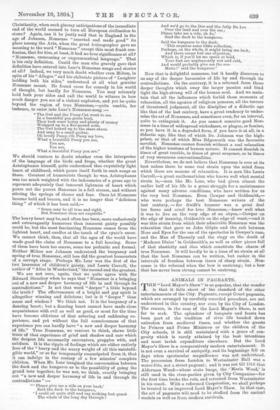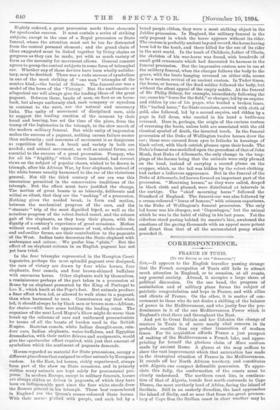ANIMALS IN PAGEANTS. T HE "Lord Mayor's Show" is so popular,
that the wonder is that it falls short of the standard of the other entertainments of the City. Pageants, except Court pageants, which are arranged by carefully recorded precedent, are not understood in this country, nor even by the City of London. The reason, in the case of the Lord Mayor's Show, is not far to seek. The splendour of banquets and feasts has been part of the tradition of civic life handed down unbroken from medimval times, and whether the guests be Princes and Prime Ministers or the children of the City schools, it is still maintained with a grace of con- gruity which is rarely attained by the best intentions and most lavish expenditure elsewhere. But the Lord Mayor's Show is a comparatively modern entertainment. It is not even a survival of antiquity, and its beginnings fell on days when spectacular magnificence was not understood. The procession from London to Westminster Hall was a water-fete, not a street pageant ; and it was not till 1816 that Alderman Wood—whose state barge, the Maria Wood,' is still used in the river-parties given by City Companies—for the first time broke the rule, and returned from Westminster in his coach. With a reformed Corporation, we shall perhaps be treated to an improved Lord Mayor's Show. In that case, the art of pageants will need to be studied from the ancient models as well as from modern survivals. Rightly ordered, a great procession needs three elements for spectacular success. It must contain a series of striking subjects, except in the case of a Royal procession or State funeral, where the attention must not be too far distracted from the central personal element ; and the grand chain of ideas suggested must be linked together by living chains as gorgeous as they can be made, yet with as much variety of form as the necessity for movement allows. General consent agrees to group the central subjects in some form of triumphal oar. Whether any of these devices have been wholly satisfac- tory, may be doubted. There was a rude success of symbolism in one of the most striking of "One man" triumphs of the sombre kind,—the burial of Nelson. The funeral-car was a model of the bows of the Victory.' Bat the emblematic or allegorical car will always give the leading ideas of the great pageant. Between these, bands of men, on foot or on horse- back, but always uniformly clad, each company or squadron in contrast to the next, are the natural and necessary links. The unity of movement of disciplined men, able to suggest the leading emotion of the moment by their tread and bearing, has set the time of the piece, from the tramp of the legionaries in the triumph, to the slow march of the modern military funeral. But while unity of impression makes the success of a pageant, nothing causes failure sooner than uniformity ; and sameness of movement is as dangerous as repetition of form. A break and variety in both are needed ; and animal movement, as well as animal forms, are essential to the success of a great procession. Pompey, who for all his "frigidity," which Cicero lamented, had correct views on the subject of popular shows, wished to be drawn in triumph, after his African War, by four elephants, instead of the white horses usually harnessed to the car of the victorious general. Not till the third century of our era was this innovation permitted in the conservative traditions of the triumph. But the effect must have justified the change. The motion of great beasts is so leisurely, deliberate and withal so silent, that they are the " making " of a procession. Nothing gives the needed break, in form and motion, between the mechanical progress of the cars, and the 4( staccato" trip of the most dignified biped, BO well as the noiseless progress of the velvet-footed camel, and the solemn gait of the elephants, as they keep their places, with the dignity of a century's experience of great occasions. Motion without sound, and the appearance of vast, whole-coloured, and unfamiliar forms, are their contribution to the pageants of the West. Indian taste decorates the State elephant with arabesques and colour. We prefer him "plain." But the effect of an elephant column in an English pageant has not yet been tried.
In the four triumphs represented in the Hampton Court tapestries, perhaps the most splendid pageant ever designed, the cars of victory are drawn by four white horses, four elephants, four camels, and four brown-skinned buffaloes with enormous horns. Other elephants walk by themselves, a reminiscence perhaps of the part taken in a procession at Rome by an elephant presented by the King of Portugal to Leo X, which knelt at the Pope's feet. But animals produce a finer effect when led, or allowed to walk alone in a pageant, than when harnessed to cars. Connoisseurs say that when led, it should always be by black men or brown men—African, for choice—with bare arms holding the leading reins. The organiser of the next Lord Mayor's Show might do worse than break up the columns of cars and uniformed processionists by teams of all the beasts of burden used in the British E aspire. Bactrian camels, white Indian draught-oxen, rein- deer cars, Indian elephants, water-buffaloes, and Egyptian dromedaries, with their native drivers and equipments, would give the spectacular effect required, with just that amount of symbolism which the sentiment of pageants demands.
Horses regarded as material for State processions, occupy a different place from that assigned to other animals by European custom. In the East, led horses, richly caparisoned, always form part of the show on State occasions, and in princely stables many animals are kept solely for processional pur- poses. In modern Europe, except in military funerals, horses are always ridden or driven in pageants, of which they have been an indispensable part since the four white steeds drew the Roman general in his triumph. Those best remembered in England are the Queen's cream-coloured State horses. With their manes plaited with purple, and each led by a broad purple ribbon, they were a most striking object in the Jubilee procession. In England, the military funeral is the only pageant in which the horse appears without its rider. The custom is probably ancient beyond record, the horse having been led to the tomb, and there killed for the use of its rider in the next world. In the tomb of Childeric, father of Clovis, the skeleton of his war-horse was found, with hundreds of small gold ornaments which had decorated its harness in the funeral procession. But the impressive custom now in use at the military funeral, when the charger follows the body to the grave, with the boots hanging reversed on either side, seems to be a modern revival of an ancient custom. In Tudor times, the horse, or horses, of the dead soldier followed the body, but without the silent appeal of the empty saddle. At the funeral of Sir Philip Sidney, for example, immediately following the car, came his "horse for the field," or charger, led by an esquire and ridden by one of his pages, who trailed a broken lance. His" barbed horse," for State occasions, covered with cloth of gold, also followed, led by a second esquire, and ridden by a page in full dress, who carried in his hand a battle-axe reversed. Here is, perhaps, the origin of the curious custom of reversing the boots, unless both are associated with the old classical symbol of death, the inverted torch. In the funeral procession of the Duke of Wellington twelve horses drew the car; these were covered from eyes to fetlocks in housings of black velvet, with black ostrich plumes upon their heads. The Duke's funeral was modelled upon the precedent of that of John Monk, first Duke of Albemarle, the only change in the trap- pings of the horses being that the animals were only pluraed on the head, instead of carrying a second plume on the crupper, which, as the tail was hidden by the velvet clothing had rather a ludicrous appearance. But in the funeral of the Duke of Albemarle, led horses formed an important part of the procession. "Mourning horses," as they were called, draped in black cloth and plumed, were distributed at intervals in the cortege. The "chief mourning horse" followed the Standard of England. The funeral-car was also followed by a cream-coloured "horse of honour," with crimson caparisons, in the Duke of Wellington's funeral procession. The only led horse was his charger, not 'Copenhagen,' but the animal which he was in the habit of riding in his last years. Yet the riderless steed pacing behind its master's bier, awakened the emotions of the gazing thousands with an appeal more potent and direct than that of all the accumulated pomp which preceded it.







































 Previous page
Previous page